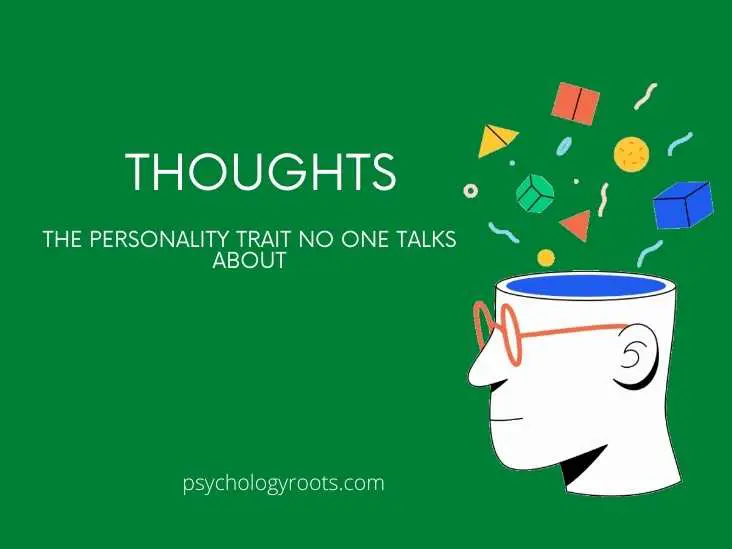Table of Contents
Thoughts: The Personality Trait No One Talks About
Here in this post, we are discussing and learning about “Thoughts: The Personality Trait No One Talks About”. You can read more about psychology-related material on our website. Keep visiting Psychology Roots.
A person’s unique set of characteristics, or “personality traits,” are the recurring patterns of thoughts, emotions, and actions that define them (Johnson, 1997).
There are many more alternatives not discussed in my earlier piece. A friendly and warm-hearted individual who likes complimenting others can be an example of someone who talks lovely things. Mental processes such as contemplation and reflection, as well as affective and behavioral responses, are all equally significant, according to textbook author David Funder (2019). We normally employ behavioral attribute phrases to define personality and then relate to thoughts and emotions to comprehend and explain those actions.

Thoughts The Personality Trait No One Talks About
Thoughts
Despite the equal relevance of thoughts, emotions, and action in our explanations of personality, personality research has concentrated more on feelings and behaviors than thoughts. One probable explanation for this is because there are considerably more personality attribute phrases in the natural language that relate to acts and emotions than to thoughts.
Consider the well-known and extensively utilized Big-Five Model of Personality, which was constructed by examining personality attribute terms (Goldberg, 1990). (Goldberg, 1990).
Most of the trait labels for the first four of the Big-Five components (extraversion, agreeableness, conscientiousness, neuroticism, and openness) describe things that individuals do (i.e., behaviors) or feel. For example, the attribute adjectives social, forceful, chatty, affectionate, and friendly define the actions of extraverted individuals. Because extraverts have a tendency to feel good about themselves, traits like being cheerful and having a good time are common among them. Agreeable persons are regarded as trustworthy, humble, kind, helpful, and joyful. Conscientious persons are persistent, thorough, loyal, and hard-working. Neurotic persons are defined mostly using emotion trait terms such as moody, jealous, scared, uneasy, and timid.
Only the fifth of the Big-Five elements has a considerable amount of terms pertaining to thoughts. This element, variously termed Intellect, Imagination, or Openness to Experience, expresses the personality type using terms such as imaginative, creative, inquisitive, and intelligent.
Research on Personality-Related Thoughts Already Done
When it comes to categorizing various actions and thoughts, the Big-Five Model is universally recognized. However, academics have yet to agree upon a method for classifying regular patterns of thinking. In reality, personality psychologists seldom try to define what a personality-relevant thought is, or how thoughts vary from emotions. Sometimes psychologists refer to personality-relevant thoughts as cognitive style. The APA Dictionary of Psychology defines cognitive style as, “a person’s distinctive manner of seeing, thinking, remembering, and problem-solving.” Fine. What, then, are these many ways of seeing, thinking, remembering, and solving problems? The creative vs. down-to-earth cognitive style indicated by the fifth element of the Big Five is one example of cognitive style. But nobody has come up with a full list of cognitive styles.
One technique to investigate personality-relevant cognition is to assess a person’s persistent ideas about the world. For example, some individuals consider that we live in a fair world, where everyone finally receives what they deserve. The strength of this conviction may be tested using different Just World scales. Research reveals that believing in a fair universe may serve an adaptive purpose, but can also be used to rationalize anti-social conduct.
The idea that the world is either a hazardous or a safe place depends on one’s personality type. Prejudice, trust, despair, and loneliness have all been linked to this idea, according to a study conducted by a fellow PT writer at the University of Pennsylvania. Research on personality-relevant beliefs may be found by clicking the first link on this page.) Despite the fact that beliefs do not directly cause emotions or actions, they have a substantial impact on both of these aspects of our lives.
Despite the lack of agreement on the whole spectrum of personality-relevant thoughts and how to categorise these thoughts, efforts have been made to incorporate cognitive styles and beliefs into a comprehensive framework. I detailed one such effort in a recent piece regarding perceptions of wealth and scarcity. In addition, I’ve done some study on the basic ways in which we come to understand the world. (If you would like to complete an online version of the inventory that I utilized in this study, the Organicism-Mechanism Paradigm Inventory (OMPI), click this link to the OMPI.)
Summary
A person’s unique set of characteristics, or “personality traits,” are the recurring patterns of thoughts, emotions, and actions that define them. A friendly and warm-hearted individual can be an example of someone who talks lovely things. Research has concentrated more on feelings and behaviors than thoughts. Academics have yet to agree upon a method for classifying regular patterns of thinking. Sometimes psychologists refer to personality-relevant thoughts as cognitive style. The APA Dictionary of Psychology defines cognitive style as a person’s distinctive manner of seeing, thinking, remembering, and problem-solving.
Reference
- Funder, D. C. (2019). The personality puzzle (8th edition). New York, NY: Norton.
- Goldberg, L. R. (1990). An alternative “description of personality”: The Big-Five factor structure. Journal of Personality and Social Psychology, 59(6), 1216-1229. https://doi.org/10.1037/0022-3514.59.6.1216
- Johnson, J. A. (1997). Units of analysis for description and explanation in psychology. In R. Hogan, J. A. Johnson, & S. R. Briggs (Eds.), Handbook of personality psychology (pp. 73-93). San Diego, CA: Academic Press. https://doi.org/10.1016/b978-012134645-4/50004-4
Help Us Improve This Article
Have you discovered an inaccuracy? We put out great effort to give accurate and scientifically trustworthy information to our readers. Please notify us if you discover any typographical or grammatical errors.
Make a comment. We acknowledge and appreciate your efforts.
If you have any scale or any material related to psychology kindly share it with us at psychologyroots@gmail.com. We help others on behalf of you.